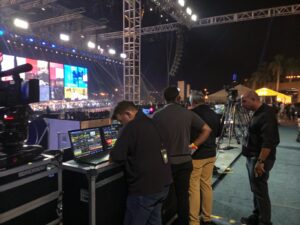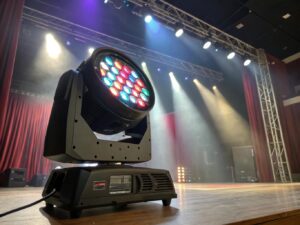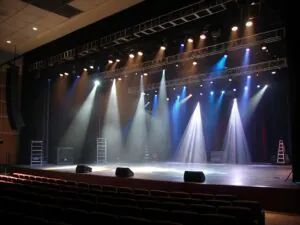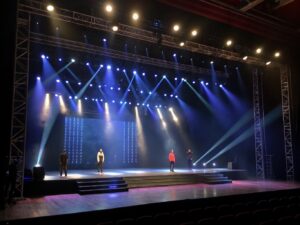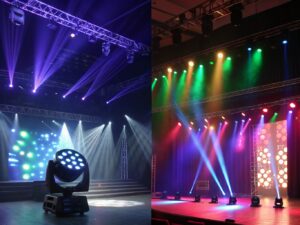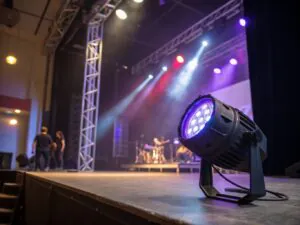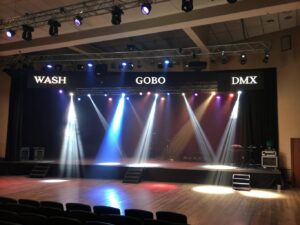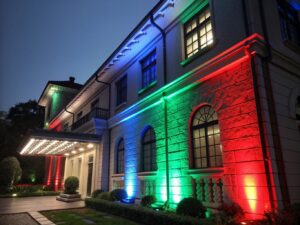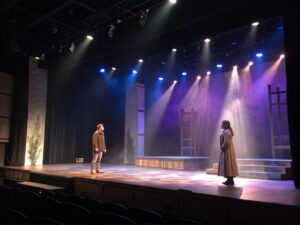
What Must You Know Before Adding Lasers to Your Stage?
You're tempted by the incredible energy laser effects1 can bring to a show. But you're held back by rumors of legal trouble, safety concerns, and technical confusion, leaving this powerful tool unused.
Before using lasers, you must know they are legal in the US only with an FDA variance, they are a specialized tool for sharp beams and effects, not a replacement for LED washes, and they are a form of visible light, not UV light.

I remember when lasers first became accessible for stage use. There was so much excitement, but also a lot of fear. As a technician back then, I had to learn a whole new set of rules. After 19 years in this business, I've seen how innovation, like the laser, can transform a stage. But my philosophy remains: "quality is life, innovation is soul." This means embracing new tools responsibly. Lasers are one of the most powerful tools in our arsenal, and as your trusted partner, I want to give you the confidence to use them safely and effectively.
Are laser lights legal in the US?
You want to create stunning laser effects, but you're worried about getting hit with huge fines or even having your show shut down. The legal risks seem too high to even try.
Yes, professional laser lights are legal in the US, but they are heavily regulated by the FDA. To use any laser over 5mW for a public display, you must obtain a "variance" from the FDA and follow strict operational safety rules.

This is the biggest hurdle for newcomers, but it's all about safety. When I was starting out, securing the right permits was a complex process, but it taught me discipline. The FDA's Center for Devices and Radiological Health (CDRH) classifies lasers based on their potential hazard. For any professional show, you will be using a Class 3B or Class 4 laser. Getting a variance is basically proving to the FDA that you know how to operate these powerful devices without endangering the public. This includes things like appointing a Laser Safety Officer (LSO), ensuring beams don't scan the audience unless you have specific safety systems, and setting up proper termination points for all beams. It's a serious responsibility, but it's the only way to operate legally and professionally.
Laser Classifications and Safety
| Laser Class | Power Level | Key Requirement for Public Display |
|---|---|---|
| Class 3R | 1-5 milliwatts (mW) | Can cause eye damage with direct, prolonged viewing. Still requires care. |
| Class 3B | 5-500 milliwatts (mW) | Dangerous. Direct viewing can cause immediate eye injury. Requires an FDA variance. |
| Class 4 | Over 500 milliwatts (mW) | Extremely dangerous. Can cause instant eye and skin damage, and is a fire hazard. Requires an FDA variance. |
What is better, LED or laser?
You have a limited equipment budget and need to decide where to invest. Should you buy more versatile LED fixtures2 or specialized lasers? The wrong choice could leave you unprepared for future jobs.
Neither is "better"; they are different tools for different jobs. LEDs are the workhorses for washing a stage with color and providing general illumination. Lasers are the specialists for creating intensely bright, razor-sharp aerial beams and graphic effects.

Thinking one can replace the other is a common mistake. It's like asking if a paintbrush is better than a pen. A lighting professional like Nick knows he needs both in his toolkit. The soul of our work at Monalight is innovation, and lasers represent a unique innovation that complements LEDs perfectly. LEDs create the foundational mood with broad washes of color. Then, lasers come in to add the high-impact "wow" factor with effects that are impossible to create with an LED source. A truly dynamic show uses the strengths of both technologies. The best investment is a balanced inventory that allows you to create layers of light—a soft base with a sharp, exciting accent. A skilled technician knows how to blend them to create a single, cohesive look.
LED vs. Laser: The Right Tool for the Job
| Feature | LED Fixtures | Laser Projectors |
|---|---|---|
| Beam Quality | Wide-angle, soft-edged beam that diverges (spreads out) quickly. | Extremely narrow, sharp beam that travels long distances with little divergence. |
| Best Use | Washes. Creating ambient color, lighting backdrops, general illumination. | Effects. Aerial beams, liquid sky effects, projected text and logos. |
| Coverage | Excellent for covering large areas with color. | Very poor for general coverage; it's a single point of intense light. |
| Luminance | Bright, but the light is spread over a wide area. | Unmatched perceived brightness because all energy is in one tiny beam. |
| Flexibility | Great for color mixing and general-purpose lighting. | Highly specialized for creating a specific type of high-impact effect. |
Is laser light an UV light?
You hear about the power and potential danger of lasers, and you might wonder if they emit harmful, invisible radiation like ultraviolet (UV) light. This concern about unknown risks can be intimidating.
No, the laser light used in professional entertainment projectors is visible light, not UV light. It is created at specific wavelengths that our eyes perceive as red, green, or blue, and does not contain harmful UV radiation.

This is a very important safety distinction that ties directly back to my core value: "quality is life." The danger from a laser is not from its type of light, but from its intensity. The light itself is just a very pure, concentrated form of the same colors an LED produces. The electromagnetic spectrum3 ranges from radio waves to gamma rays. UV light has a shorter wavelength and higher energy than visible light, which is why it can damage skin and eyes. Professional entertainment lasers are carefully engineered to produce light only within the visible spectrum (roughly 400-700 nanometers). For example, a common green laser operates at 520nm, which is right in the middle of what we can see. A quality-built laser projector ensures that no stray UV or infrared light leaks out.
This is why partnering with a trusted manufacturer is critical. Low-quality, unregulated units might not have the proper filters, but a professional-grade fixture guarantees that the light you are using is pure, visible color.
Conclusion
To use lasers professionally, get the proper FDA variance, use them as a special tool alongside your LEDs, and trust that quality fixtures produce safe, visible light to energize any stage.
You may also be interested in:
